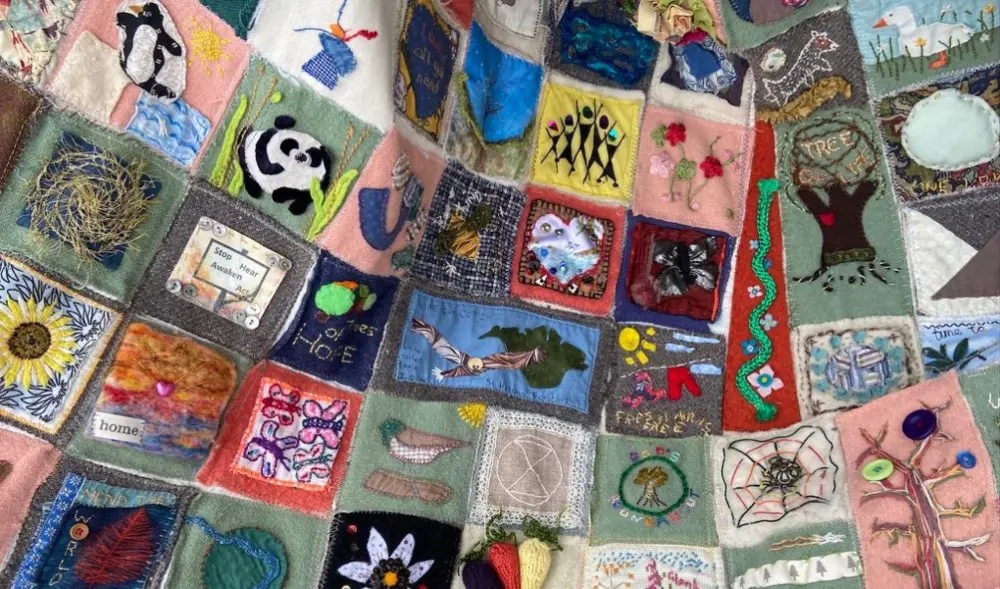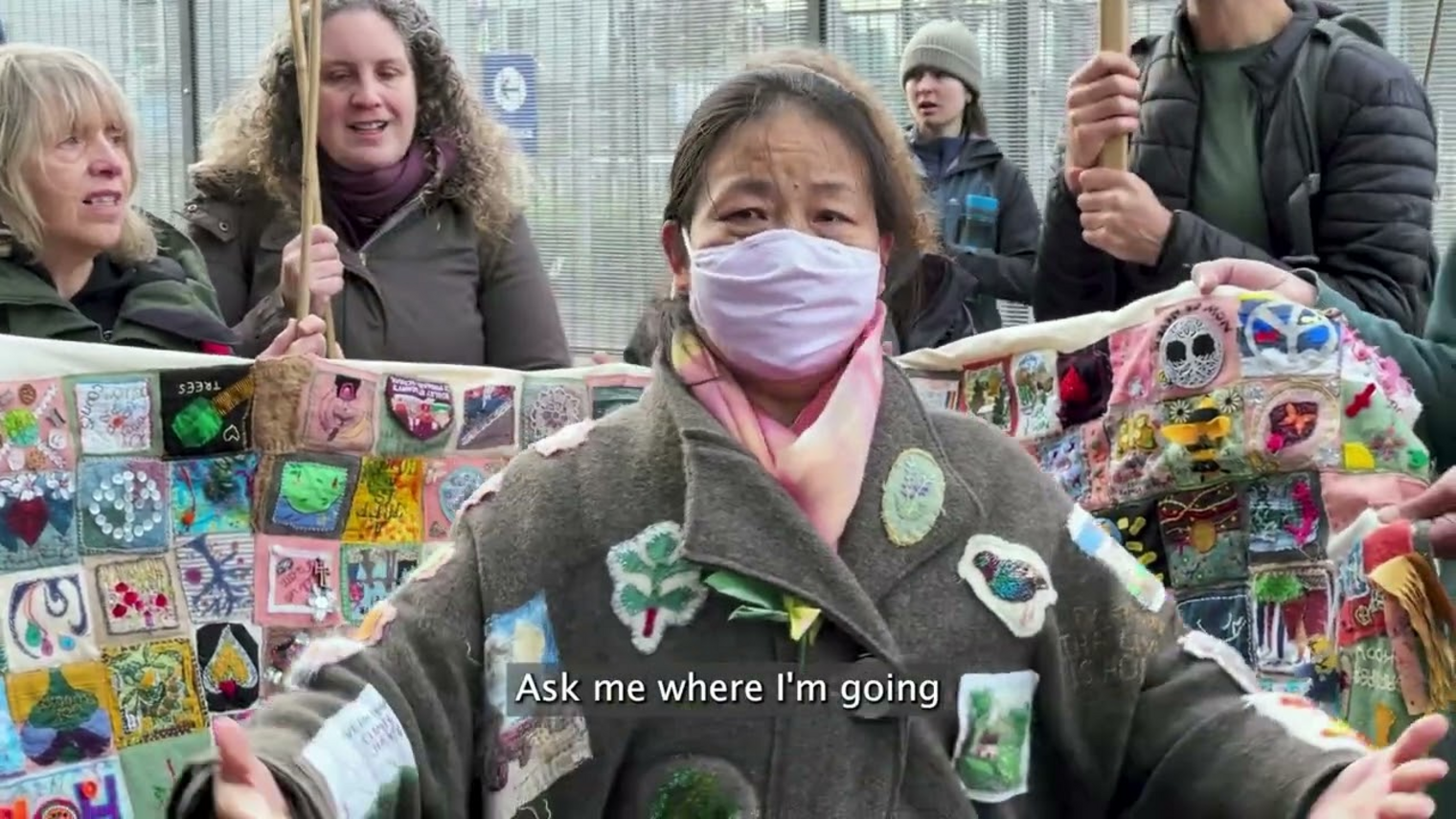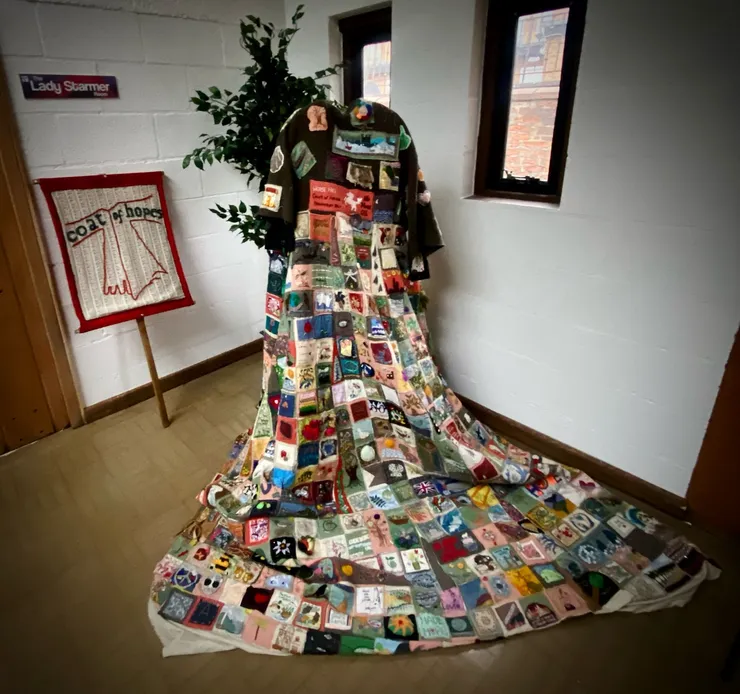Pilgrimage as field research: Experiences during a Journey with the "Coat of Hopes"

Photos: Mark Porter
As part of his field research about the connection between faith, music and climate activism, our colleague Mark Porter went on a pilgrimage with the Coat of Hopes. In this interview, he talks about his experiences, the participants' motivations and the reactions of the people the pilgrims encountered along the way.
Can you tell us something about the idea behind the "Coat of Hopes" and about how you got to know about it?
The Coat of Hopes is a kind of faith-adjacent interactive art-based climate activism. The project was initiated by an artist called Barbara Keal in the run-up to the COP 26 Climate summit in Glasgow a couple of years ago. The idea was to create a piece of art that acquired its meaning through the different encounters it had and through the journey it went on rather than through the work of the artist who made it. Anyone who wanted to was invited to make a patch which would then be attached to the coat. The patches were there to represent people’s hopes in relation to the climate crisis and they are still being added to the coat a couple of years later.
The coat began its journey of pilgrimage from the south of England up to Scotland by foot. Different people would join the journey at different points, sleeping on church halls and other community buildings wherever they were offered an invitation. As the coat made its journey, anyone that the group encountered along the way was invited to put on the coat as a symbol of warmth but also of the weight of responsibility we all share. Through these different encounters, different people became part of the journey of the coat, and many of them have been incredibly moved by the invitation. Since that initial journey to Glasgow the coat has continued its journey, moving through different communities around the country, and it’s grown now to include over 600 patches, with a total weight of around 9 kilograms.
I got to hear about the project because the coat has a song which is sung along the journey. I’ve been interested for the last few years in the connection between faith, music, and the climate crisis, and when I heard about the project I got in touch with the artist behind the project to find out more about the story behind it. This was initially a one-off interview, but we’ve had occasional email exchanges since that original conversation, and she invited me to join the coat on part of its journey earlier on this year. Since I’d written about the coat as part of my research, it felt right to join the project for a couple of days and see it face to face. That’s how I ended up walking through the North of England in the cold and the wind a couple of weeks ago after a cold and sleepless night on a church hall floor.

Please note: Once you watch the video, data will be transmitted to Youtube/Google. For more information, see Google Privacy.
What kind of people did you meet there? What were their motivations for going on the pilgrimage?
When I signed up to walk with the coat for a couple of days I really had very little idea what to expect. Different people come and go for different parts of the journey, sometimes it’s a small group, and sometimes it’s bigger. In our case, we started off with a fairly small group of five people. The leader and route planner had come up from London, and she is someone who actually leads hiking expeditions for a living. One member of the group had come down from a Quaker community in Scotland, one member had been living in the forest for a couple of years in a tent, and one had recently come out of a rehabilitation programme.
Alongside that core group there were a range of other people who joined us for a day or two along the way. One of them worked as an engineer buildings trains, another led stone-carving workshops and worked as a sculptor. The group brought with them a broad range of different spiritualities and expectations, some people came because they’d encountered the coat on a previous journey and it had been something meaningful to them, others hoped that they might have some kind of encounter or find some kind of meaning along the way.
A lot of climate activism tends to attract middle-class white people, and this pilgrimage wasn’t a complete exception to that rule, but I did feel that it was an interesting group with a lot of different perspectives.
Along the journey we stopped off at two churches and a Quaker meeting house. I found it interesting at the churches how quickly some people were moved to tears when they tried on the coat. I had no idea that an object could be that moving to someone. That made an interesting contrast to the quaker group, who were much more interested in reflecting upon the climate crisis together and talking about the societal challenges ahead of us.
We encountered a range of different people as we were walking. On the first day we ran into the local MP, who agreed to try on the coat and have his photo taken. After that, we ran into an Australian woman leading her own climate action projects, a range of local people who displayed different degrees of enthusiasm to try on the coat or keep a distance from it, a climate denier who was keen to get into an argument, and we also went through a couple of areas with relatively high drug-use, which brought with it a different kind of encounter. It was very clear along the way that some people were deeply moved by engagements with the coat, some engaged a little reluctantly, and others really wanted to keep their distance from the whole thing.

Pilgrimage and climate activism appear to be quite an unusual connection, since many people might think of pilgrimage more as a personal spiritual journey. How did those two dimensions work together in your experience?
I haven’t been on that many pilgrimages, and in many ways I feel under-qualified to comment on that question. I think it was really important to those involved in this project that the coat offers a genuine invitation to everyone and isn’t perceived as an act of opposition or protest. To that extent, it’s different from some more high-profile forms of climate activism as it emphasises the importance of inclusion and seeks to acknowledge the challenges and existential anxiety that so many people have, regardless of their commitment to a particular climate agenda.
I think that some people on the pilgrimage did see the walk as a kind of spiritual journey, and some of them found that those hopes were met, whilst I think others found some level of disappointment that the journey didn’t achieve everything they’d been placing upon it. I had a conversation with the creator of the coat after the pilgrimage to reflect on some of that, and we talked a little about the way these dynamics of hope, experience, and disappointment are actually remarkably common dynamics when it comes to journeys of pilgrimage.
One of the hardest moments for us came when we were walking through a massive out-of-town shopping centre surrounded by multi-lane roads that were congested with cars, and where it was clear that we were in a space that just wasn’t meant for walking.
In this kind of environment, the coat really felt like quite a foreign object, and there wasn’t so much a sense that we were doing something spiritually meaningful as that climate engagement is massively foreign to massive parts of our society. The pilgrimage journey takes you through all kinds of different experiences and spaces, but I think the thing that really tied together everyone on the journey was the sense that for at least some people, in at least some of those spaces this was something that could become meaningful, and that some of that potential was really worth hanging onto.
Do you think that initiatives like this can actually make a difference or at least make people aware of climate change and the problems that are linked to it?
I don’t think that anyone we ran into was unaware of climate change, and I think they were all aware of at least some of the problems and challenges that it brings with it. I think the difference that this kind of project makes is in helping some of those people to feel a part of something bigger, to realise that their hopes and anxieties connect with the hopes and anxieties that other people are also feeling, and to receive a moment of affirmation that there is that kind of resonance between their own experience and the experiences of others. It’s not a project that can solve the climate crisis on its own. But it’s a project that can help in some of the emotional and spiritual work that people need to do in facing this crisis, and we shouldn’t underestimate the value of those kinds of dimensions when it comes to shaping the direction we are heading in as a society.
You can find more information on the Coat of Hopes on the dedicated website:
